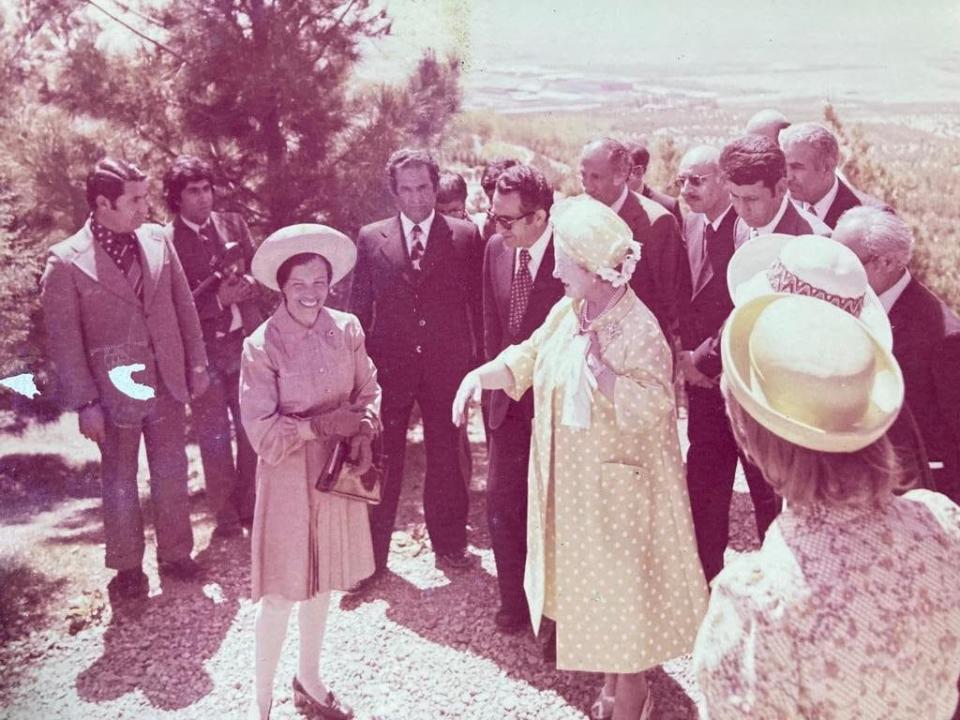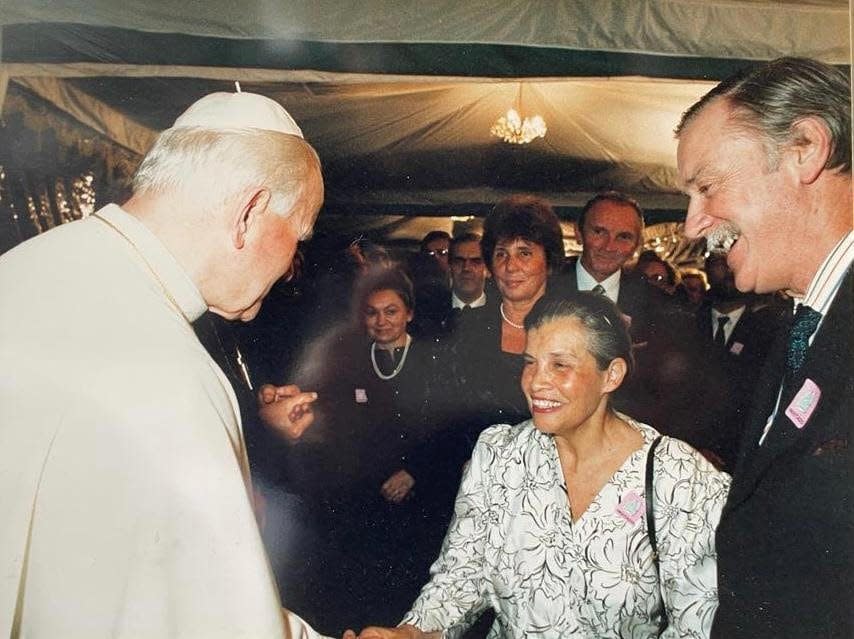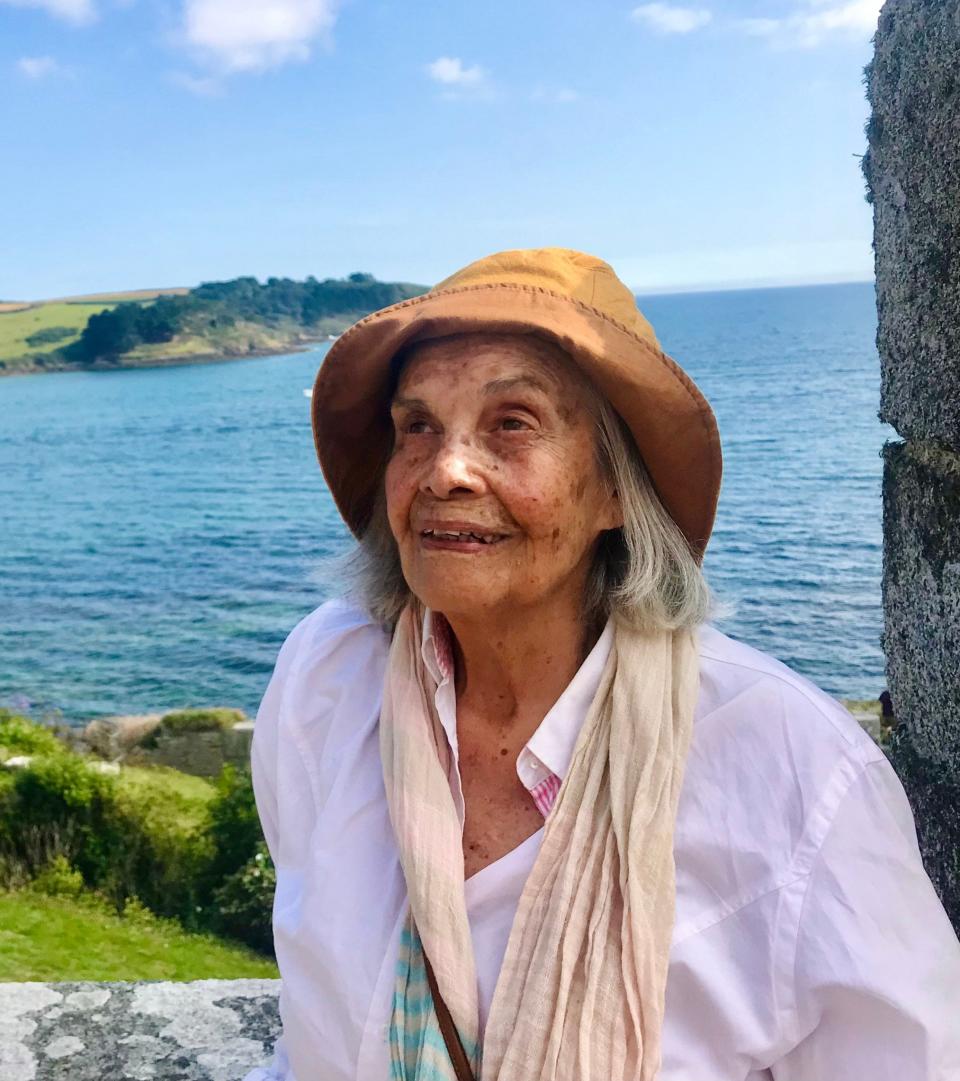Lady Simpson-Orlebar, Colombian-born wife of a British diplomat whose energy and charisma could defuse all tensions – obituary

- Oops!Something went wrong.Please try again later.
Lady Simpson-Orlebar, who has died aged 88, was a popular and highly effective diplomatic wife in Iran, Portugal and Mexico, her Latin warmth and friendliness perfectly complimenting the old-fashioned English diffidence of her husband, Sir Michael, whose distinguished ambassadorial career owed much to her natural exuberance and limitless hospitality.
She was born Rosita Duarte Triana on June 23 1934, some 30 miles north of Colombia’s capital, Bogotá. The youngest of seven children, she grew up in prosperity on her family’s country estate until a crash in the global coffee market coincided with her father falling from his horse, breaking his back, and having to hand over his business affairs to a well-meaning but incompetent relative.
The civil war in Colombia, known as La Violencia (1948-58), was just beginning and Rosita, then aged 14, was sent away to Switzerland to complete her education. She was always vague as to when her school studies finished but, determined not to return too soon to Colombia, she made her escape to England, where she found work as a nanny and then qualified as a nurse at Putney Hospital.
Back in Bogotá in the early 1960s, Rosita joined the Canadian Embassy, where her connections and fluency in English and French were valued assets. Her circle of friends included several artists and one or two boyfriends with fast cars.
But in due course she fell for a young British diplomat, Michael Simpson-Orlebar, a former top scholar, president of Pop and Captain of School at Eton, whose gentle disposition belied his skill on the dance floor. They married in 1964, a year before his stint as First Secretary (Commercial) in Bogotá came to an end.
Rosita and her husband appeared to see nearly everything differently, but they constructed an unusually close and happy marriage, and a comedy of contrasting manners which enchanted their friends and all who came across them.

There followed postings in London, Paris, and Tehran, which had been Michael Simpson-Orlebar’s first overseas posting and where he returned as Commercial Counsellor in 1972 during the oil-price boom and the high days of the Shah.
By the time they returned to London in 1976 both their sons were at prep school in England, Rosita finding the separations very hard and often bemoaning “this barbaric English custom”. Now living only three miles from their school in Sussex but seeing them scarcely more often, she appointed herself the school’s official birthday-cake maker so she could legitimately visit the school at least once a week.
Deliveries often coincided with her sons’ afternoons on the sports field, and they eventually told her it was not “cool” to have her cheering them on during mere practice sessions.
After the fall of the Shah in 1979 and the proclamation of the Islamic Republic, the British Embassy in Tehran was downgraded, and when they returned in 1983 with Michael Simpson-Orlebar as Britain’s most senior diplomat, he was head of the “British Interests Section” rather than ambassador.
The country was in the throes of the Iran-Iraq War, and the former embassy where they lived flew the Swedish flag. It was a very uneasy time in Anglo-Iranian relations, but amid a series of diplomatic crises Rosita Simpson-Orlebar’s talent for friendship did much to lessen antipathy towards Britain, while the numerous social and charitable events she organised raised the spirits of the entire diplomatic community across the Cold War divide.

There followed a far more tranquil posting, to Portugal, where Michael Simpson-Orlebar became ambassador in 1986. The Lisbon embassy (now sadly sold and converted into luxury flats) was one of Britain’s most enchanting diplomatic residences, situated on a hill overlooking the city with a beautiful walled garden to the rear.
Lord Hailsham had a narrow escape there when a centuries-old olive tree keeled over within an inch of his chair, but he took away with him pleasant memories of the effervescent “ambassadress” cutting sweet peas which her husband had cultivated from English seed.
The ambassadress seemed to be everywhere, whether bringing together the wives of the Portuguese president and prime minister in a campaign to address the influx of hard drugs into Portugal, or being filmed for TV bargaining in the city’s food markets ahead of a large embassy dinner, which she always took the lead in preparing.
The 600th anniversary of the Anglo-Portuguese alliance – the oldest such treaty in existence – was celebrated soon after the Simpson-Orlebars arrived, entailing a visit by Prince Charles and Diana, Princess of Wales, to commemorate the Valentine’s Day marriage between Philippa of Lancaster (the daughter of John of Gaunt) and King John I of Portugal in 1397.
The strains in Charles and Diana’s own marriage were already all too apparent, however, and the Princess’s ostentatious flirtation with the Portuguese president Mário Soares was diplomatically awkward. But the Simpson-Orlebars were adept at defusing such tensions and during their tour did much to reinvigorate the historic bilateral ties and boost Anglo-Portuguese trade. They were fondly remembered by the Portuguese long after they left to take up Michael’s final overseas posting, as Ambassador to Mexico, in 1989.

Rosita Simpson-Orlebar’s enthusiasm and idiosyncrasies, once encountered, were not easily forgotten. She had an uncommon ability to make everyone she talked to feel special, often holding the hand of whomever she was speaking to. The connections she made went well beyond the diplomatic, as she immersed herself and made friends in each country they lived in.
Her quirks included her old-fashioned Spanish, rooted in the Bogotá of the 1950s and 1960s and overlayed with her own particular vocabulary. Only when her children studied O-level Spanish did they realise that “mi lechugita” (“my little lettuce”) or “mi coliflor” (“my cauliflower”) were not common Colombian terms of endearment.
If Colombia was her place of birth, the town of Needham Market in Suffolk became her home. In 1995, when her husband retired from his final job, as director general of Canning House in London, they bought Tudor House, opposite the church in Needham Market, which became a visual narrative of their itinerant life together, interspersed with a seemingly indiscriminate collection of knick-knacks – or “chunches” as they say in Spanish. Among many letters of condolence her family received was one from a local charity shop, recalling Rosita Simpson-Orlebar’s great generosity as a buyer over the years.
After Sir Michael Simpson-Orlebar died in 2000, staying on at Tudor House was a simple choice for her. “It’s where my Marcolino is,” she would say, evoking one of the many names she called him.
And there was no arguing with that, whatever misgivings her children had in her later years as she applied her multi-limbed technique to move between floors, clambering up a dozen uneven and winding steps, worn down over 600 years, protesting that the house was entirely suitable for her.
Rosita Orlebar-Simpson is survived by their two sons and daughter.
Lady Simpson-Orlebar, born June 23 1934, died January 8 2023

